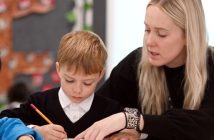
At Sunday’s International Preschool Education Conference (IPEC), literacy specialist Dr. Julie Wood led a workshop on creative teaching for beginning readers and writers. The interactive workshop was a chance for participants to learn more about dialogical reading in order to make time spent reading with children more effective and enhance creativity. The technique can be used by parents or teachers and focuses on having a conversation about the book.
Dr. Wood is also an international literacy consultant and served as a faculty member and former Director of the Jeanne Chall Reading Lab at the Harvard Graduate School of Education (HGSE). The program was founded for training teachers and reading specialists, conducting research in reading, and serving the local community. In addition to her writing featured in numerous educational publications, Dr. Wood’s published a book called Literacy Online.
“Dialogical Reading is about vocabulary, comprehension, and the enjoyment of reading,” says Dr. Wood. “We talk about the story, we ask questions, and we laugh at the jokes together because we’re having fun with the book.”
With the help of an assistant, Dr. Wood demonstrates dialogical reading for the audience. Dr. Wood acts as “parent” while her assistant plays the role of the “child.” Dr. Wood begins by showing the child two or three pre-selected books to choose from. Dr. Wood suggests regular library visits to engage children in choosing their own books. It’s important to note that the pre-selected books are level appropriate to the child’s comprehension level and that the length of the stories, sophistication of ideas and language developments should also be important considerations. Secondly, Dr. Wood allows the child one or two minutes to choose a story based on flipping through the pictures and looking at the covers. She suggests the following guiding statements and questions to parents and teachers:
Let’s look at it.
What do you think it’s going to be about?
Who do you think wrote it?
Let’s look at the back.
Once the child has chosen a book and parent and child (or teacher and children) have discussed what the story might be about, the parent can then read the story, with the pages facing the child, while asking engaging questions. In partners, the audience has the chance to try the role-play activity. For some, the technique comes naturally, while other parents and teachers find the process quite difficult. Dr. Wood says dialogical reading will become more natural the more it’s practiced. “Trying new techniques can be hard. If I say something, I want to make it important to them. We don’t want to overdo it, so try not to ask too many questions because that distracts from the story.”
Dr. Wood suggests using character voices and pantomiming techniques to further engage the child’s interest. Some children may be very verbal and let their imaginations run wild while others want to relax and have the story read to them. The most important thing to keep in mind when practicing dialogical reading techniques is that all children are different.
Tying into the IPEC conference theme of creativity, Dr. Wood holds that books can be used by parents and educators as a springboard for the child to be creative. She suggests after-reading activities such as suggesting that perhaps the book might have a different ending and asking the child to draw a picture of what that ending could be. She also suggests music and poetry as a means for children expressing creative ideas.
If you would like to try dialogical reading at home, see below for more helpful ideas as outlined by Dr. Wood.
As you read interactively with your child, make sure to ask questions. Pay special attention to interesting or colorful words. Encourage your child to be there teller of the tale.
When you are sharing an information book together, also encourage your child to share what he or she is learning. Let the child be the one who explains the important information to you.
When your child finds a book that he loves, find out if there are more like it in a series or see if the author has written other books that your child might enjoy.
Be creative! Have your child respond to the books you read together with art or music. What type of music would make a good soundtrack to this book? What does he see in his imagination when you’re reading together?
Writing is a part of reading, the two go hand-in-hand. After you have shared a book, have your child respond in writing, either by drawing a picture of the part he liked best or help him write a word or two that captures the idea behind his illustration.
Read with others. Make reading a social event by visiting libraries and reading with the librarian and other children your child’s age or invite other children to your home to share favorite books.
Click here to read about the first IPEC workshop we attending on how to use coaching to encourage creativity.
Photo: Victoria Yang



